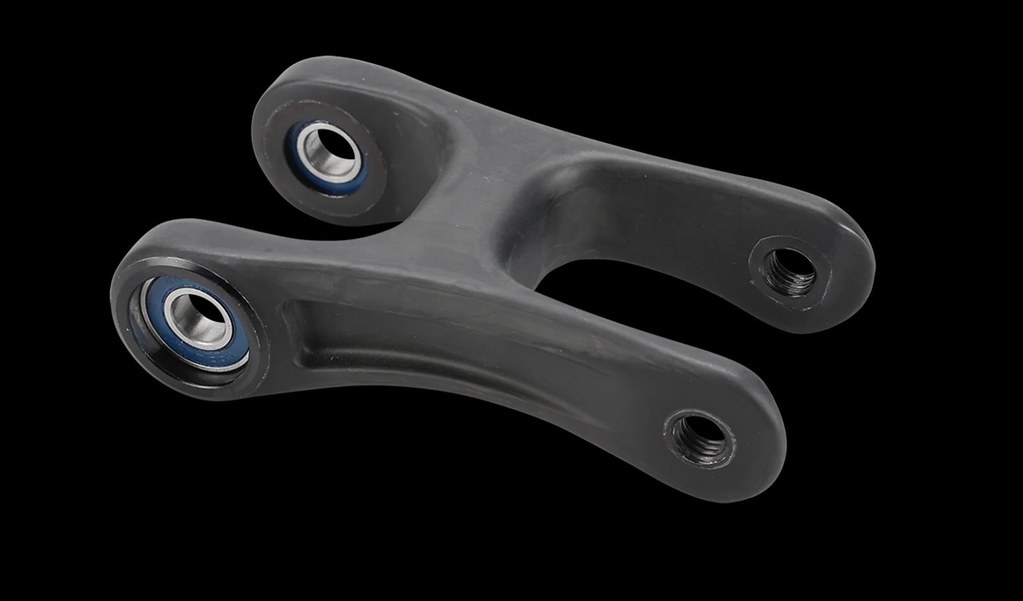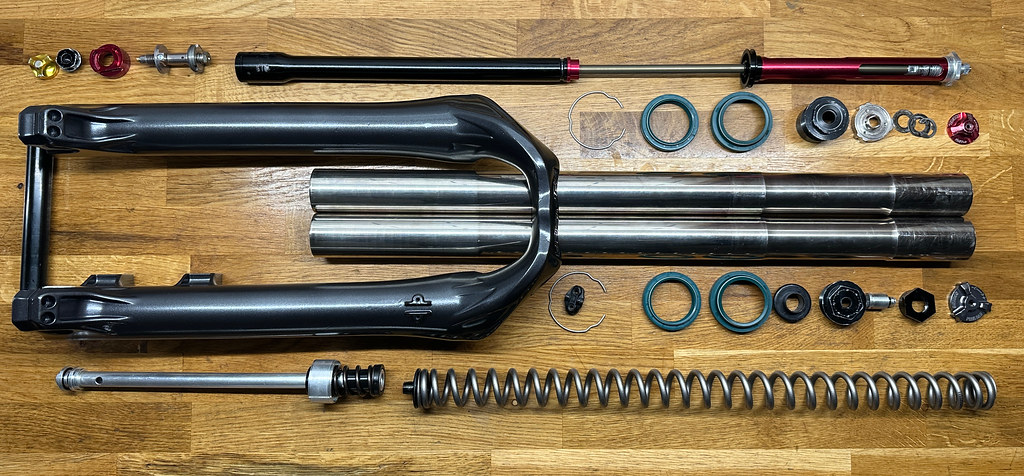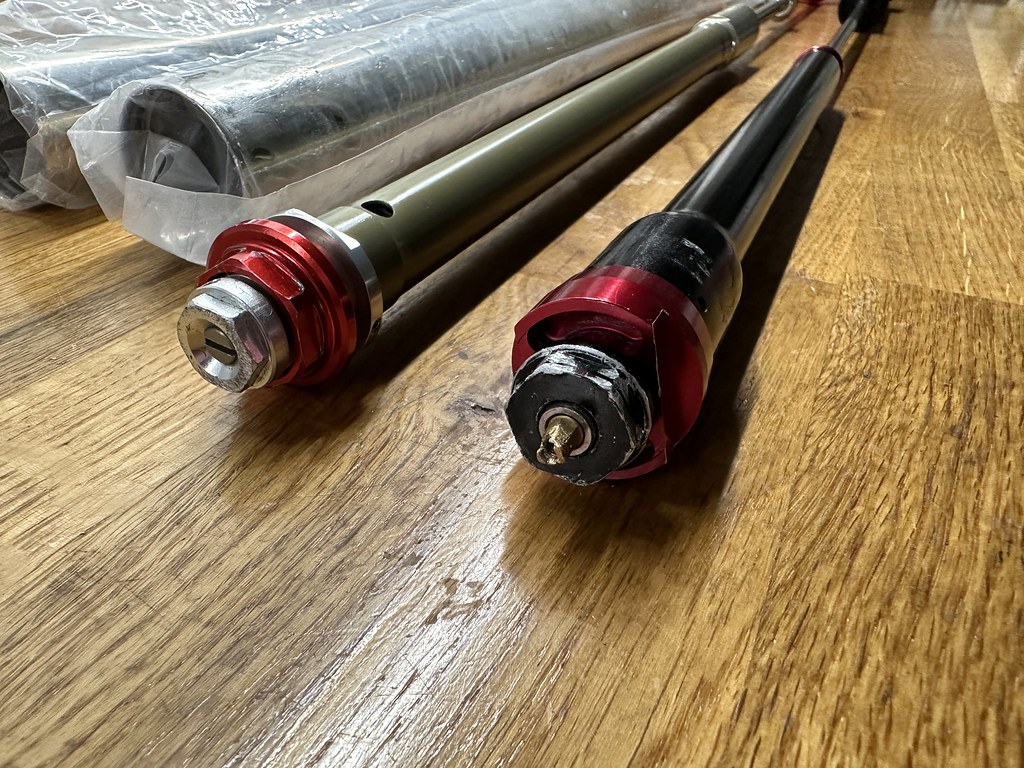Cloverleaf
Retro Guru
- Feedback
- View
Another DH bike that doesn't get ridden much. Back in 2011 I was still working for Pinkbike and they bought this for me through the UK distributor in a lovely shade of chrome grey as payment for some of the stuff I was doing for them. I raced it that season but as I returned to having a proper sponsor in 2012 (I generally preferred not to be sponsored, it made life and racing less enjoyable than just doing what you wanted when you wanted) it didn’t see much more use. However, because I hate the whole process of selling stuff I put off selling it, despite it having been repainted in luminous yellow by my mate down at Orange and built back up with new decals ready to do so. And a new lower link too, courtesy of Richard Cunningham over in Cali who picked it up for me while having dinner with Jeff Steber one night, which is a pretty cool story. Anyway, fast forward a few years and I’d stopped DH racing but still had this frame sat there so the inevitable happened and it was built back up. I'll cover some of its iterations in the text and pictures.
As it was first built in March 2011...
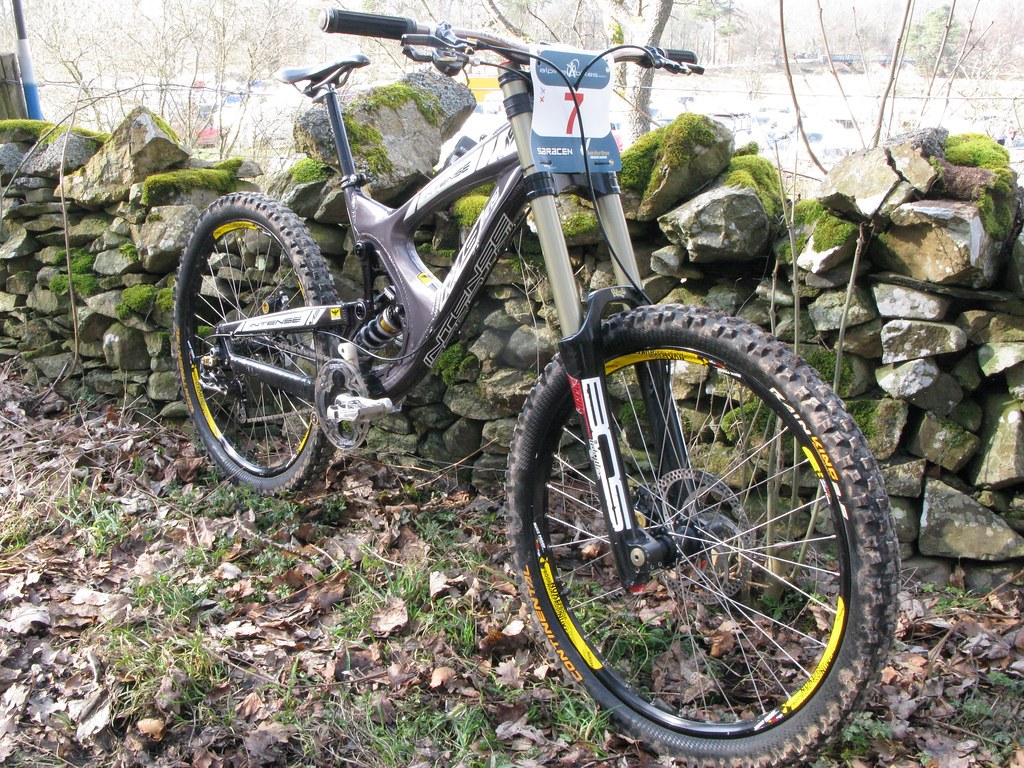
This corner is now bar deep nearly 13 years on...
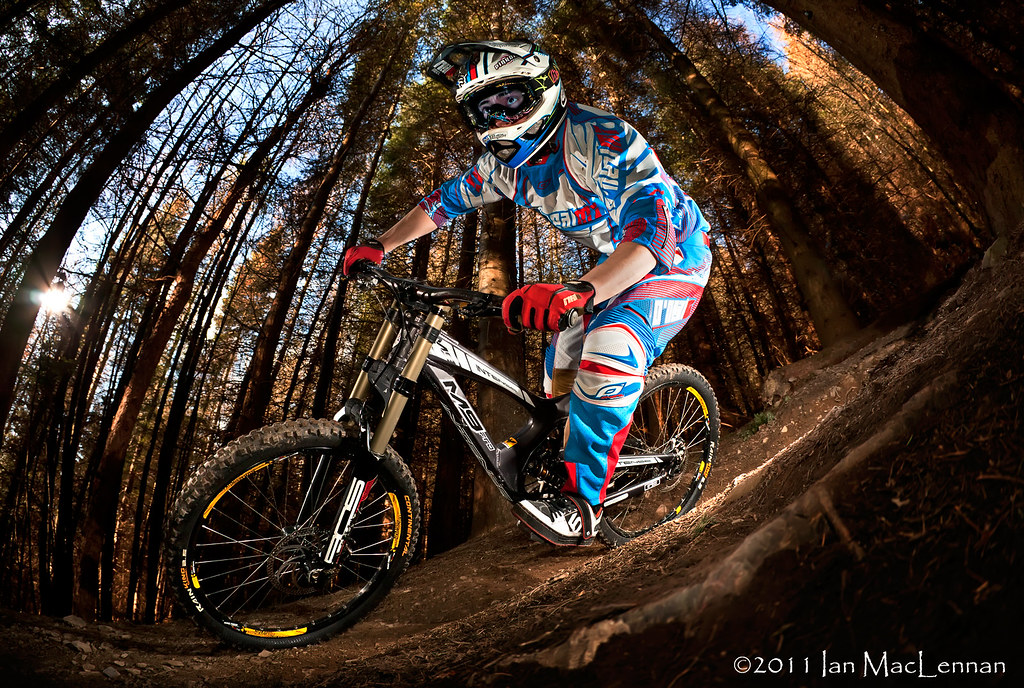
When first built up it had pretty much the best of the best on it thanks to some deals and testing for the site. Arguably the worst components on it were the Formula The One brakes I was testing, and they were still decent, just not to my taste. Back then I'd agonised over what size to go for as the medium Mk3 V10 was pretty short and I was worried about the medium M9 being too long, yet just two years later I'd custom build an enduro bike that had a wheelbase nearly 3" longer in the top tube. It now feels super short. How times change.
Well it does say 'FRO' on the head tube badge...
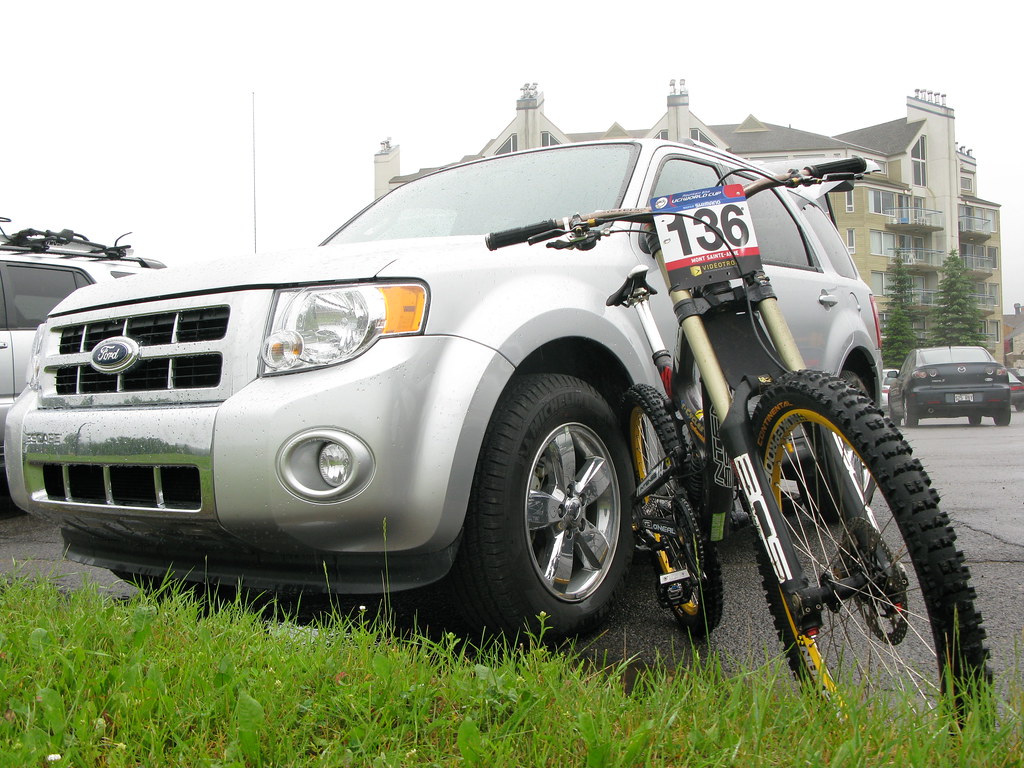
Frame: Medium Intense M9 FRO. 1.5" head tube allowed the use of the stock Cane Creek Angleset, a 150x12mm rear axle with replaceable dropouts allowing three chainstay lengths, and a front shock mount which allowed three progression levels for the spring curve, and replaceable chips in the lower swing link to give 8.5"/9"/9.5" travel. In short a very adjustable frame!
Progression adjustment - this is in max position...

Forks: More history than hot dinners.
Originally the bike was built with BOS Idylle RaRe's which on the face of it were brilliant bits of kit. And bloody expensive at something like £2k RRP. However, I paid less than 1/3 of that and still felt hard done by. The problem with lots of boutique parts is that, particularly at that time, they're usually bought by people with too much money and not enough talent. Now this isn't a jealousy thing before anyone says anything, but purely one of pragmatism; how many people of that calibre are capable of really pushing the products, and objectively comparing them effectively? And if they are capable of that, how many are going to be honest that they've just spent a lot of money and the product's crap? The damper itself was really nicely made and worked well, but the HBO (hydraulic bottom out) was too aggressive and would keep the fork sucked down at the end of the travel which is never a good thing. The lowers cracked around the brace, the seals were unobtainium and were best replaced by trimmed down Fox 36 seals. And they were heavy. All far from ideal.
Great damper, junk chassis...
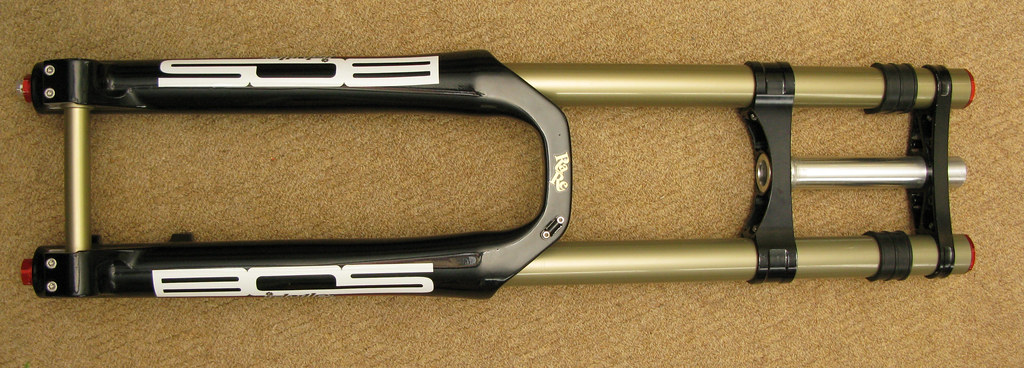
High/Low compression on the right leg. The axle is better than most setups IMO as it allows the axle to preload the hub properly while keeping the lowers aligned to the stanchions which prevents binding if your hub isn't the perfect width...
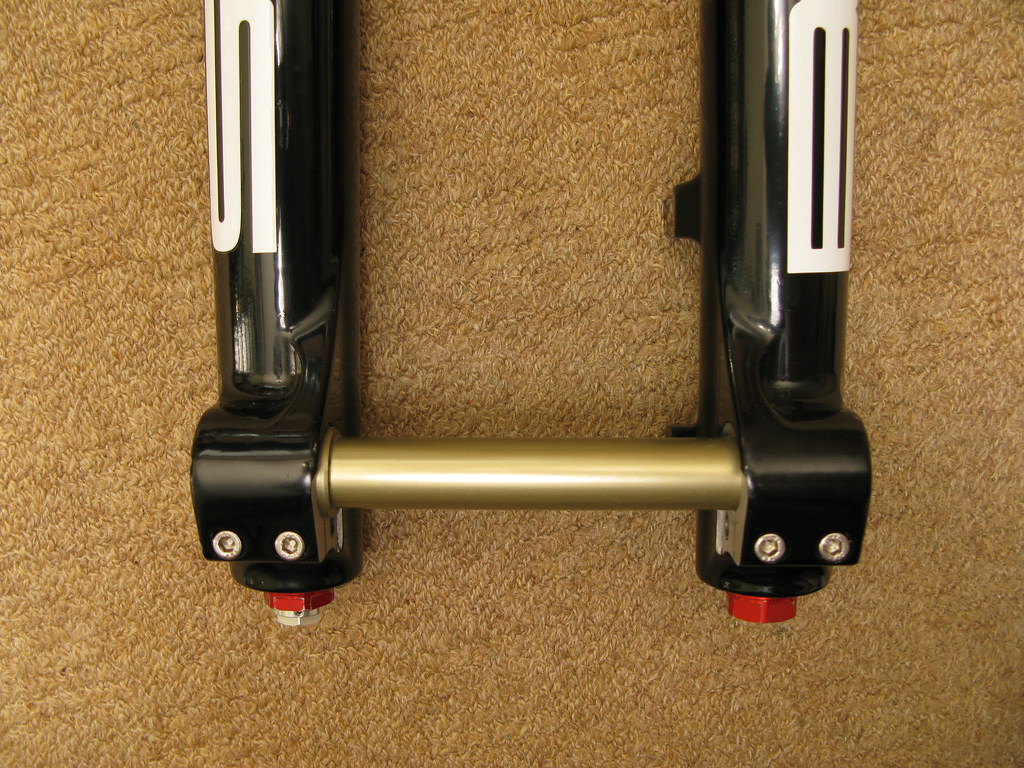
Then, when I was out racing the Mont Saint Anne and Windham World Cups in 2011 I hooked up with the Marzocchi guys to get between the two races which led to some unplanned riding in Vermont around Burke, and quite handily resulted in me being given a set of works spec 888 RC3 Evo3 WC Ti (what a mouthful) forks to test for the site. And what a revelation. Lighter, they tracked better, didn't get sucked down and were generally a better fork all round. The World Cup iteration came with a titanium spring, nickel plated stanchions and a titanium bolt set. The damper had a lot of differences in valving to the original damper, including shimmed rather than straight ported rebound, and a tuned compression stack. The other thing they had which felt like a nod to 'zocchi's of old was the progression adjuster which changed the air volume above the oil in the open damper and allowed you to dial in bottom out resistance. It always felt a lot better than the Boxxer iteration of a large rubber elastomer that kicked in rather sharply. My fork had the air cap off a 66 to also fine tune the spring rate. Of course they eventually got sold when I moved onto other bikes.
Stacked focus shot...
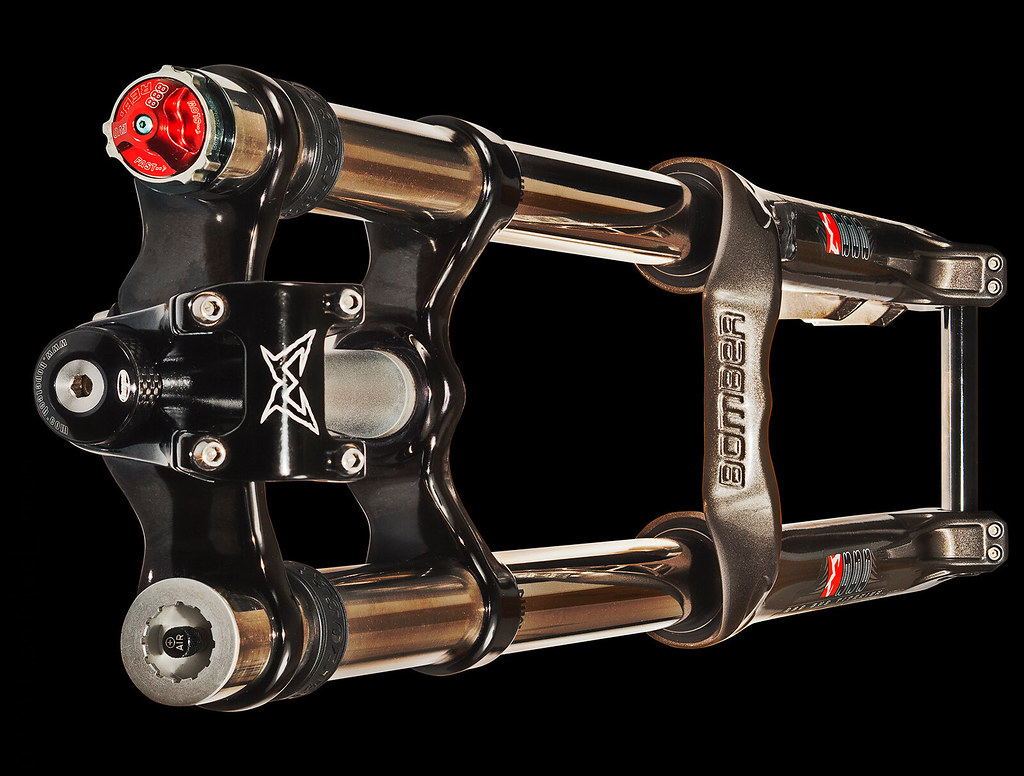
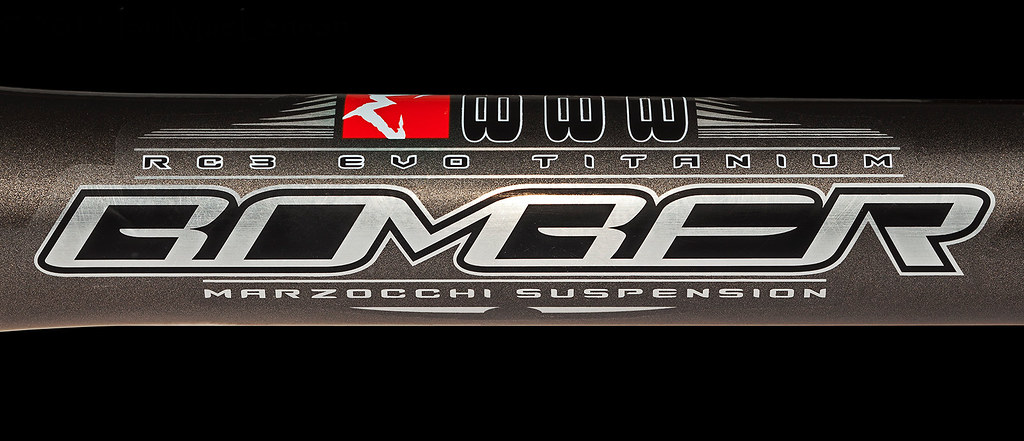
It says 'Evo' but in reality it was really quite different. I wish I'd kept it...
 Untitled by Al Mac, on Flickr
Untitled by Al Mac, on Flickr
When I first rebuilt this in 2016ish I put on a brand new pair of 2012 WC Boxxers I found in the back of a cupboard that I'd forgotten about, but I never got on with the air spring on them so was on the lookout to tracked down a pair of 2012 888's again. The axle to crown on the Boxxer was a little shorter than ideal for me, and while taller crowns were available they clouted the top tube and reduced turning circle on tight stuff. Unfortunately the replacement 888's lacked any of the factory modifications my earlier set had and were generally pretty shagged, even new SKF seals didn't really help keep the oil in. I'll cover these in detail in another post as I have plans for resolving all these issues...
Rock Shox Boxxer World Cups...

And the knackered 888s...

Shock: The Cane Creek Double Barrel was one of the top shocks at the time and is still very, very good. It was pretty much the first mass produced shock out there with four way damping adjustment but where most shocks use a major shim stack on the main piston to do most of the work and then have bypass adjusters to allow user adjustment, the CCDB uses a simpler piston and then a series of sprung loaded blow off poppet style valves with a wide range of adjustment. Great in that it can tune four different variables, not so good in that there's less internal trickery that can be done to tweak them with piston and shim stack changes. Still a great shock though. My original one cracked the body when I was using it on my later KTM Aphex so this one here is a replacement that never got used (I suspect that the KTM clouted the shock at full travel), and which when I started to use it on an Alps trip in 2018 just felt 'wrong'. When I sent it to my mate Jake at Sprung Suspension and he pulled it apart it seemed the main piston had started to undo itself along with a few other slight problems. So it was rebuilt and all upgradeable parts that could be fitted were fitted in 2020. The few times I've ridden it since it certainly feels like I remember it did back in 2011, and that's a good thing. I alternated between 400lb and 425lb titanium springs depending on track. I tend not to change setup much once settled but this is the one bike I could never quite settle on, although it was generally 400 for slower stuff and then the 425 for Euro/WC/Fort William etc.
All fixed thanks to Sprung, the CCDB Air was off my old Mega...
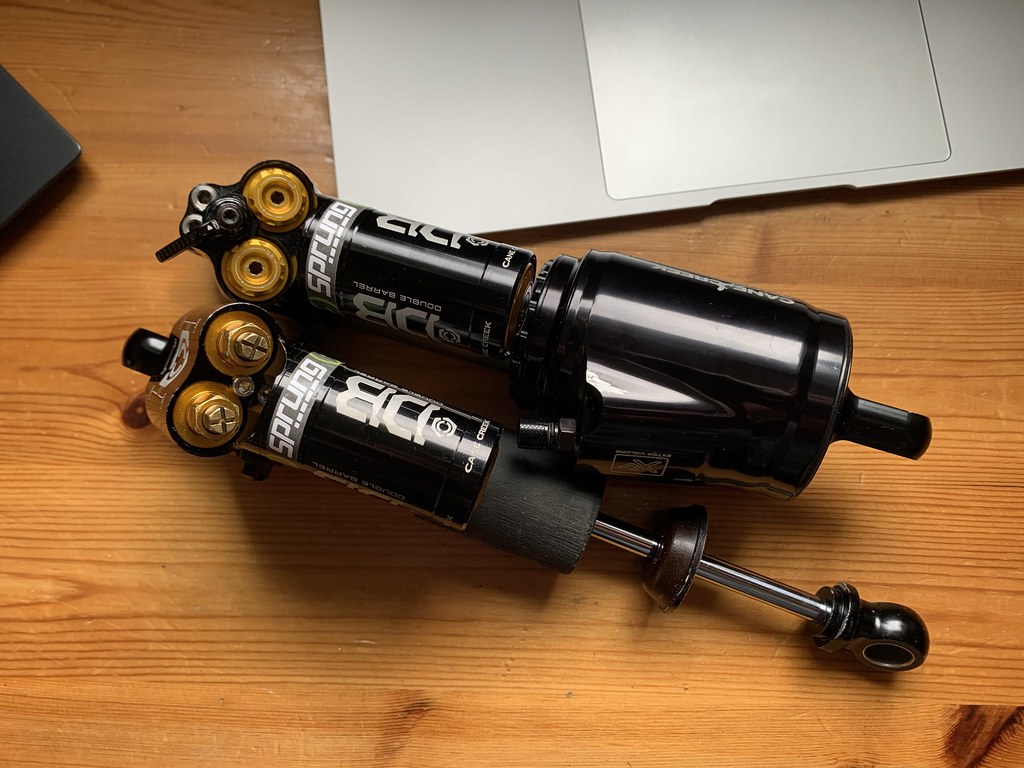
Different adjusters. Slightly annoying to need tools but Cane Creek did include a small flat pressed steel tool to do both and which also functioned as a bottle opener. Handy...
 [/url]
[/url]
Headset: These have fallen out of favour but the Cane Creek Angleset was a great way of tweaking the bike to suit. 64 degrees with stock and it came with both 0.5deg and 1.0deg adjustment cups. I generally settled on 63.5deg. Any slacker and the softness of the back end raked it out and took too much weight off the front tyre, especially on flatter tracks. They were notorious for creaking but as long as you assembled them properly so that the gimbals were free of dirt and used some good grease they were fine.
Headset cup angle marked. I started off with +0.5 as the Mk3 V10 was pretty steep and I wanted to capture some of that, but soon changed. I always built the bikes up with Ti bolts. Why? Tartness, nothing else...
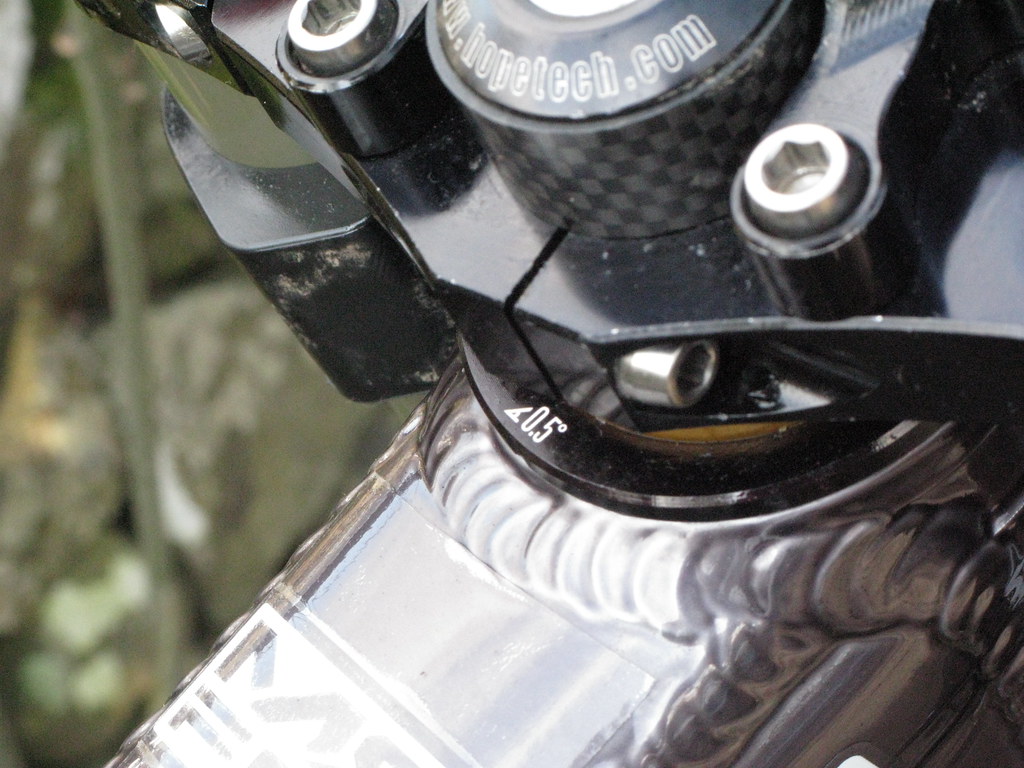
Stem: With the BOS forks this was a Hope 50mm direct mount item, then my original 888's had their own proprietary design. These later 888's have the standard four bolt direct mount pattern and for this build I fitted a Burgtec 50mm one I got from the lads at Burgtec.
The original Hope...

The new Burgtec one, including 10mm riser spacers...

Bars: Originally these were Reverse XXX's which had come as an at the time ridiculous 820mm. I ended up chopping them down to 780mm but they went with another bike and so the stem is paired with some Burgtec Ridewide DH 31.8mm Carbon 800mm bars. I've got these on three other bikes and they just feel right to me as they have a little more sweep than most.
O'Neal photoshoot...
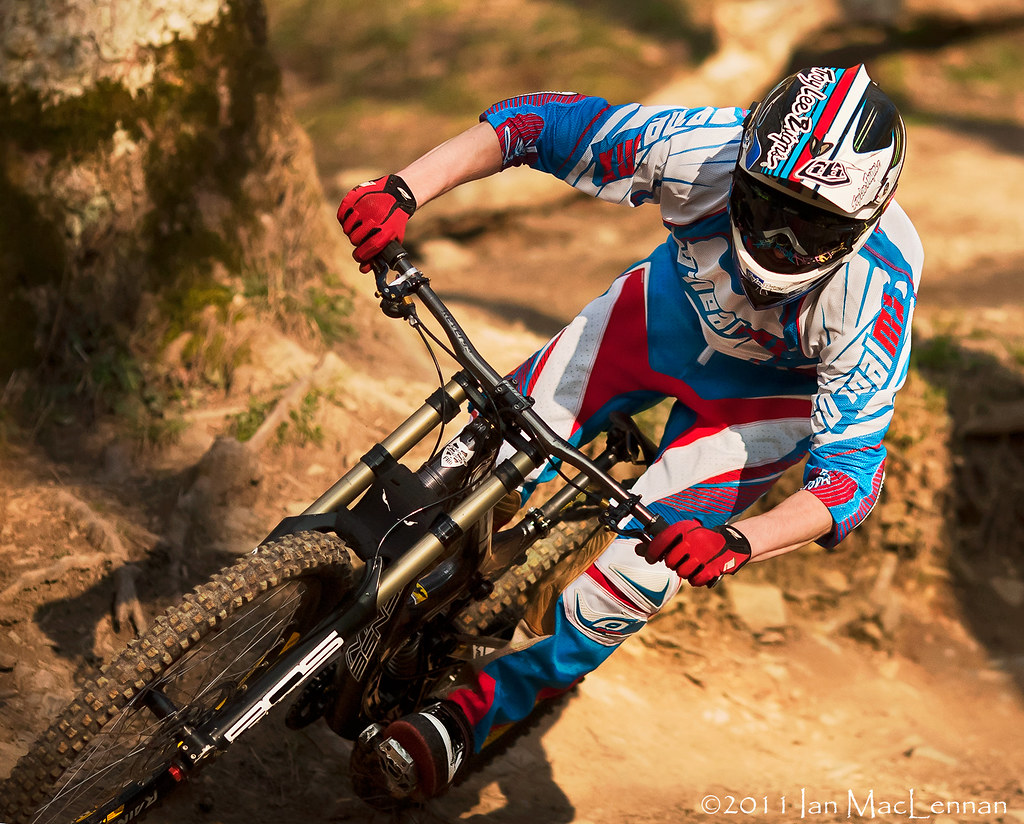
Post: I had an old 30.9mm Thomson one fitted to the bike originally, utilising a sliver of coke bottle to make it fit the 31.6mm frame, but that's long gone and so I picked up a basic Easton EA50 thing in the right size for the right price on ebay.
Grips: I like thin grips, but when you make them in lock on there's just not enough 'give' in them. Years ago I switched back to glue ons and my favourites are made by Renthal. Their ultra softs and Kevlars are pretty similar. Black US are better for bare hands, kevlar better with gloves as the fibres seem to bite into the glove well. Superglue and lock wire stop any movement.
English Champs, held rather ironically in Moelfre in North Wales...

Saddle. SDG Ti Glide. Nuff said, other than to say that like the Burgtec bars I have one of these on at least five bikes! I might have bent one or two in my time but they're usually pretty cheap to pick up used in good condition now I don't have quite the same access to 'oops, I broke it, can you send me a new one please?' option.
Cranks: The Middleburns were off the Rotec I posted here previously, then swapped to M800 Saint cranks in 83mm which came off the V10. These are the ones back on the bike now in 165mm arm length. For most of the season I raced it though I had a test set of the first generation E13 DH cranks. They looked cool but the axle creaked after a while when the ti nitriding wore off (probably from moving around) and the BB bearings weren't amazing.
Original review shot of the E13 parts...
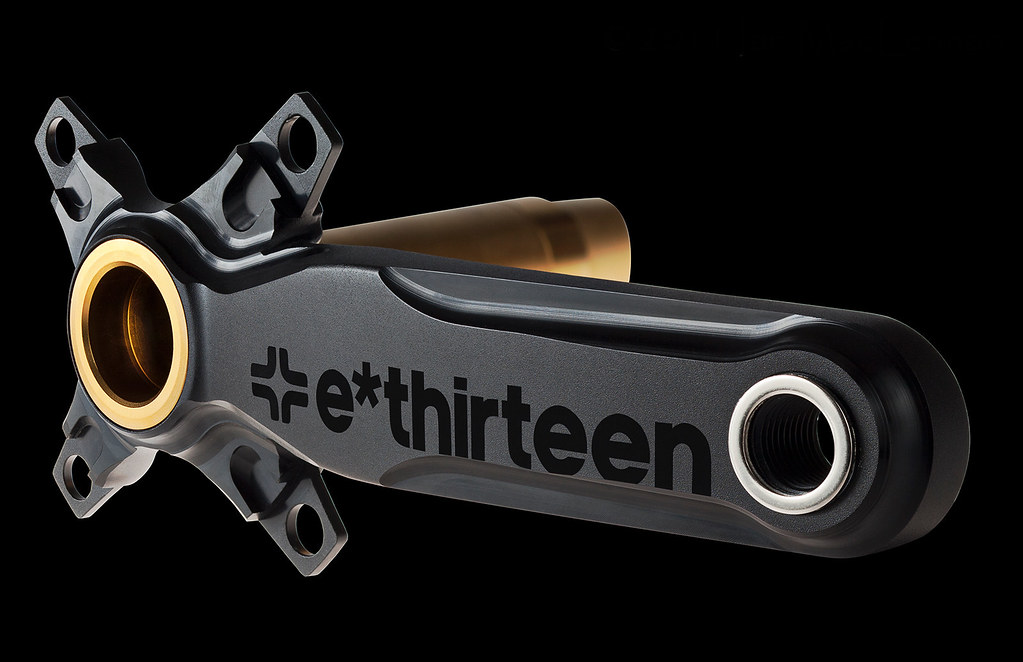
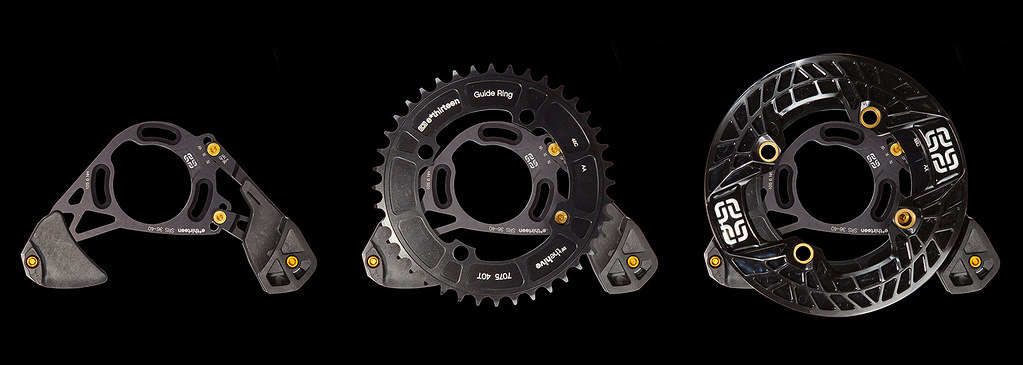
Chain Device and ring: To start with this was a spare Gamut I had which came off the previous V10 but after a few years of abuse it was tired. When the E13 cranks were fitted this was alongside the then just released latest version of the E13 SRS, and a 40T E13 DH ring. I might have mangled several bash plates and rings over the season, much to the chagrin of E13's race support guys. Suffice to say I bought quite a bit of beer for them that year!
It ain't supposed to look like that...

Shifter/Mech/Cassette: These were originally Shimano M970 XTR shifter, a bulletproof Saint M810 SS rear mech and Dura Ace CS7700 cassette in 111-25. To bring some modernity (and silence) to the bike seeing as I do actually intend to use it a bit, I've now fitted a spare M820 SS from an old enduro bike, an XTR M980 shifter and SRAM OG1090 11-25 cassette (because it was cheap).
Brakes: Most pics show these as the Formula The One's with 203mm rotors but they're far from my favourite - too on/off, and a lever that doesn't come far enough in and has an unnatural pivot point. Most of the season I used Hope Tech 2 V2's with the first generation calipers. Bulletproof, powerful and tons of feeling with a great feeling lever - I've used the Tech 2 lever pretty much exclusively since 2009. A lot of riding. Currently I've got Formula R-Ovals on there as they were spare test brakes but they'll be getting ditched soon, even though I have discovered why the front one has never held an effective bleed - check out the diaphragm seal pic below. Once I get around to getting new Tech 4 V4's for my enduro bike to replace the 2012 Tech 2 V4's currently on there, the old ones will make it to here. They were the original test brakes from the first batch of V4's back at the end of 2011 and I reckon must have done 20k km since, mostly on steep terrain, including numerous DH and enduro races, plus several Megavalanches and Mountain of Hell's. Best. Brakes. Ever.
Hope Tech 2 V2 brakes in use...
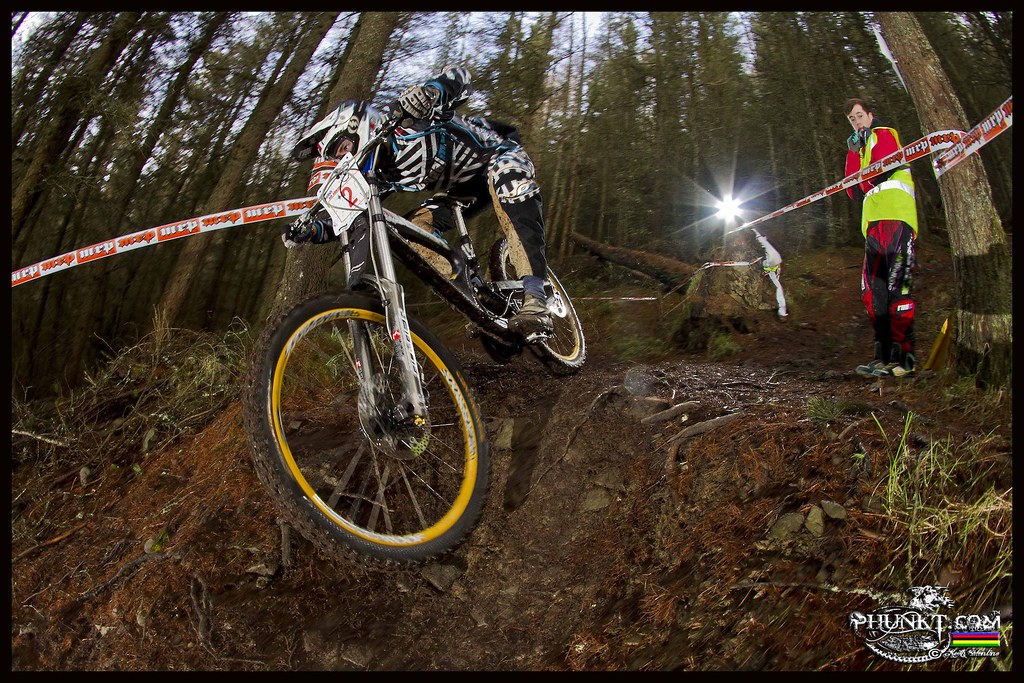
That deformed seal would explain the Formula R-Oval M/C leak...
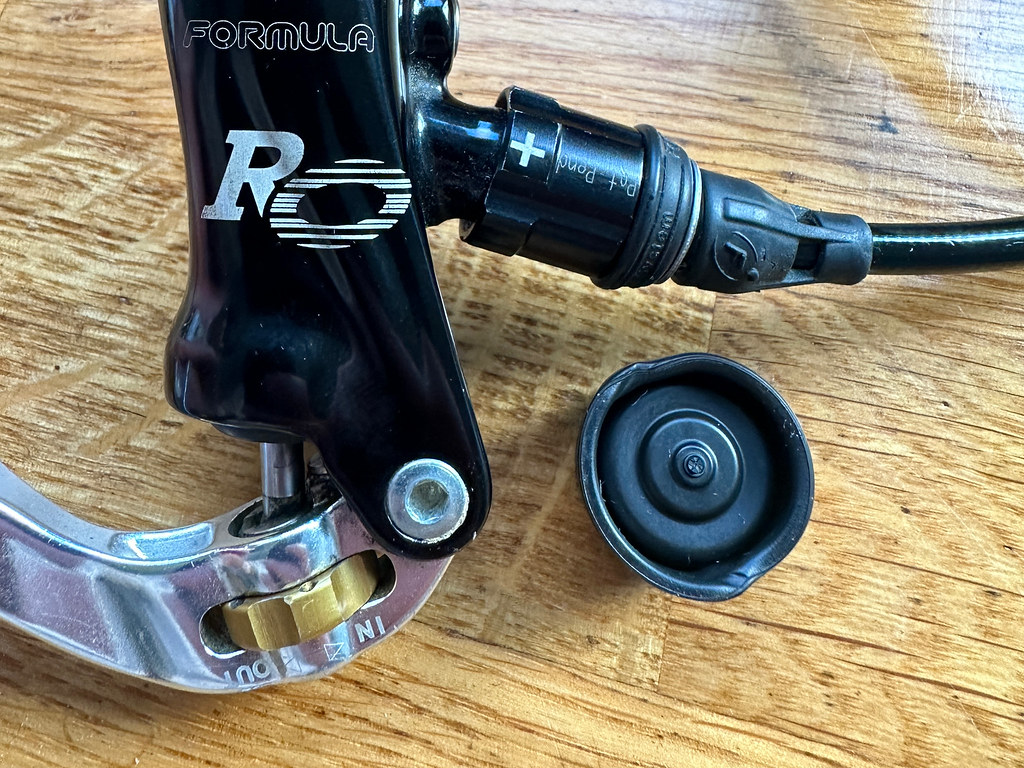
Wheels: Hope Pro II's with Sun MTX29's. The Nukeproof rims were the same, just with different stickers. I loved these because in pre-tubeless days they'd dent before puncturing, and when they were something like £15 a rim at trade I'd generally prefer to destroy several rims in a weekend rather than waste hundreds of pounds getting to and from races if I'd puncture and not be able to finish! I've now got some Hadley hubs on there with the old Mavic EX830 rims in 27.5" from my old Nukeproof Mega as there's enough space for the larger wheels with it in the long wheelbase setting and in the 888's up front. Amazingly I picked the hubs up on ebay for £65 quite a few years ago when they were built into some mint EX721's. They genuinely looked like new - a score considering how expensive the hubs are new. A spare set of Hadley wheels from the Rotec will do duty for both bikes with mud tyres, and these have been built with Stans Flow EX rims. Back in 2010-12 I was using a combination of Continental's Rain Kings and Der Kaisers depending on conditions. They were super soft compound but rolled well and gave a similar vibe to the Maxxis Minion DHF where it would be loose but hold on for days and give really predictable drift, my preferred characteristic in a tyre. I would fit the newer Continental Argotals to the 27.5" rims but I had a few spare Michelin DH22s from the old Mega enduro bike so these were fitted alongside Nukeproof ARD inserts. Not my favourite inserts but the EX830/DH22 combo just won't fit Cushcores, sadly.
Best race rims ever, Sun MTX29 or first gen Nukeproof Generator, depending on stickers...
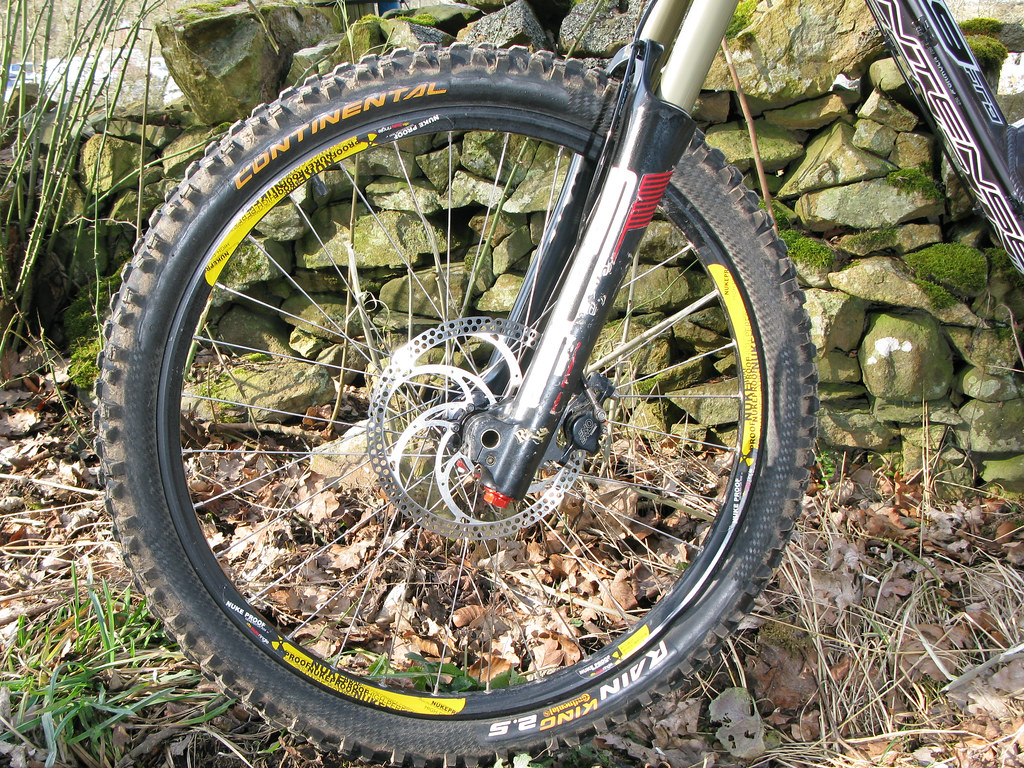
Newer Hadley goodness...

So what next? I may get the frame restored to its original Black Chrome colour, and handily I've got a spare set of the original white decals to do that. The other bit is putting my geriatric Tech 2 V4 brakes on it. And finally, I have some trickery planned for the fork but I'll cover that off once its done.
A few more obligatory riding shots...
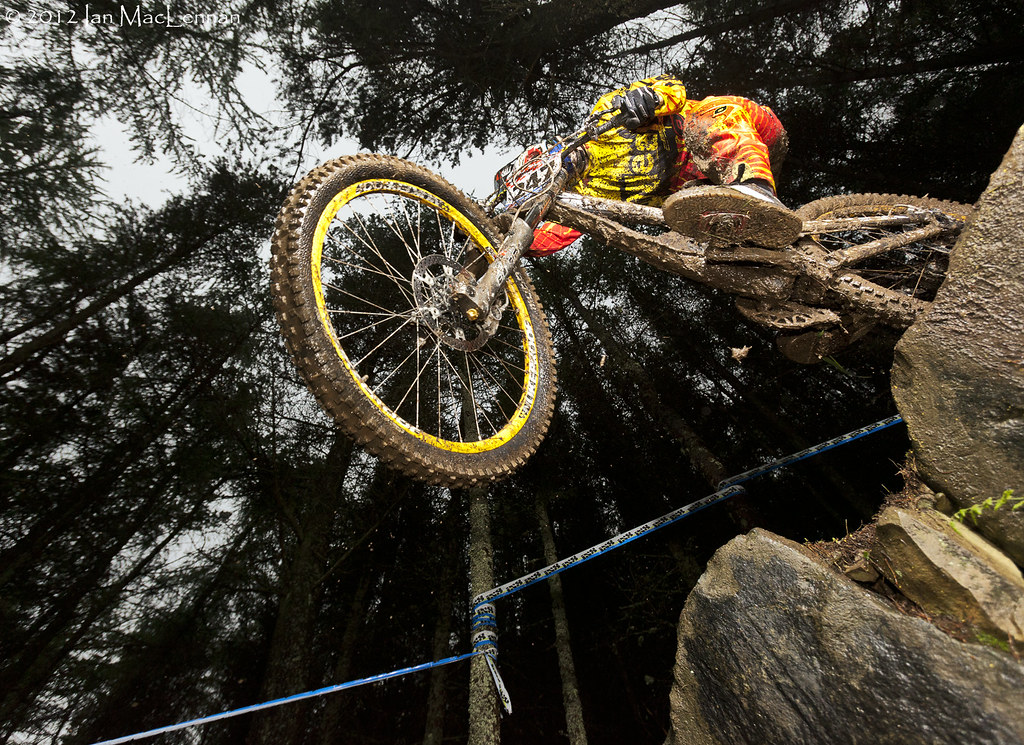

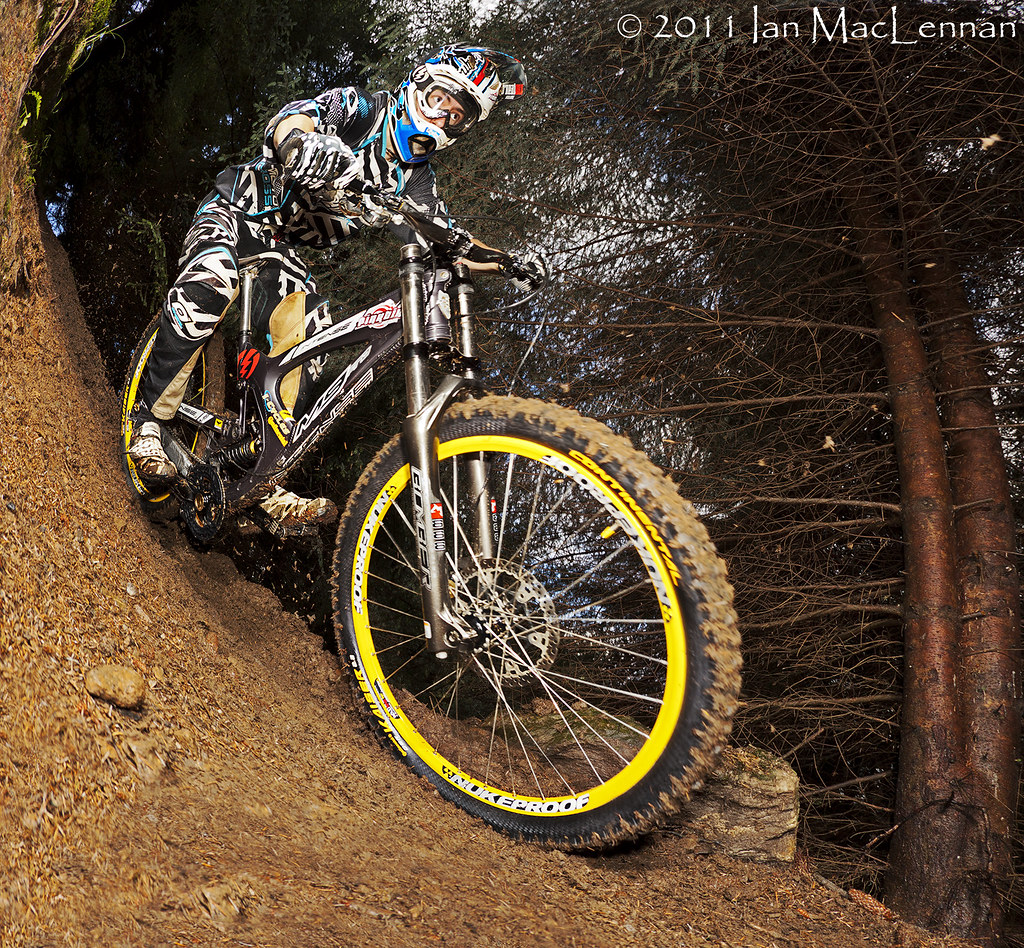
As it was first built in March 2011...

This corner is now bar deep nearly 13 years on...

When first built up it had pretty much the best of the best on it thanks to some deals and testing for the site. Arguably the worst components on it were the Formula The One brakes I was testing, and they were still decent, just not to my taste. Back then I'd agonised over what size to go for as the medium Mk3 V10 was pretty short and I was worried about the medium M9 being too long, yet just two years later I'd custom build an enduro bike that had a wheelbase nearly 3" longer in the top tube. It now feels super short. How times change.
Well it does say 'FRO' on the head tube badge...

Frame: Medium Intense M9 FRO. 1.5" head tube allowed the use of the stock Cane Creek Angleset, a 150x12mm rear axle with replaceable dropouts allowing three chainstay lengths, and a front shock mount which allowed three progression levels for the spring curve, and replaceable chips in the lower swing link to give 8.5"/9"/9.5" travel. In short a very adjustable frame!
Progression adjustment - this is in max position...

Forks: More history than hot dinners.
Originally the bike was built with BOS Idylle RaRe's which on the face of it were brilliant bits of kit. And bloody expensive at something like £2k RRP. However, I paid less than 1/3 of that and still felt hard done by. The problem with lots of boutique parts is that, particularly at that time, they're usually bought by people with too much money and not enough talent. Now this isn't a jealousy thing before anyone says anything, but purely one of pragmatism; how many people of that calibre are capable of really pushing the products, and objectively comparing them effectively? And if they are capable of that, how many are going to be honest that they've just spent a lot of money and the product's crap? The damper itself was really nicely made and worked well, but the HBO (hydraulic bottom out) was too aggressive and would keep the fork sucked down at the end of the travel which is never a good thing. The lowers cracked around the brace, the seals were unobtainium and were best replaced by trimmed down Fox 36 seals. And they were heavy. All far from ideal.
Great damper, junk chassis...

High/Low compression on the right leg. The axle is better than most setups IMO as it allows the axle to preload the hub properly while keeping the lowers aligned to the stanchions which prevents binding if your hub isn't the perfect width...

Then, when I was out racing the Mont Saint Anne and Windham World Cups in 2011 I hooked up with the Marzocchi guys to get between the two races which led to some unplanned riding in Vermont around Burke, and quite handily resulted in me being given a set of works spec 888 RC3 Evo3 WC Ti (what a mouthful) forks to test for the site. And what a revelation. Lighter, they tracked better, didn't get sucked down and were generally a better fork all round. The World Cup iteration came with a titanium spring, nickel plated stanchions and a titanium bolt set. The damper had a lot of differences in valving to the original damper, including shimmed rather than straight ported rebound, and a tuned compression stack. The other thing they had which felt like a nod to 'zocchi's of old was the progression adjuster which changed the air volume above the oil in the open damper and allowed you to dial in bottom out resistance. It always felt a lot better than the Boxxer iteration of a large rubber elastomer that kicked in rather sharply. My fork had the air cap off a 66 to also fine tune the spring rate. Of course they eventually got sold when I moved onto other bikes.
Stacked focus shot...


It says 'Evo' but in reality it was really quite different. I wish I'd kept it...
 Untitled by Al Mac, on Flickr
Untitled by Al Mac, on FlickrWhen I first rebuilt this in 2016ish I put on a brand new pair of 2012 WC Boxxers I found in the back of a cupboard that I'd forgotten about, but I never got on with the air spring on them so was on the lookout to tracked down a pair of 2012 888's again. The axle to crown on the Boxxer was a little shorter than ideal for me, and while taller crowns were available they clouted the top tube and reduced turning circle on tight stuff. Unfortunately the replacement 888's lacked any of the factory modifications my earlier set had and were generally pretty shagged, even new SKF seals didn't really help keep the oil in. I'll cover these in detail in another post as I have plans for resolving all these issues...
Rock Shox Boxxer World Cups...

And the knackered 888s...

Shock: The Cane Creek Double Barrel was one of the top shocks at the time and is still very, very good. It was pretty much the first mass produced shock out there with four way damping adjustment but where most shocks use a major shim stack on the main piston to do most of the work and then have bypass adjusters to allow user adjustment, the CCDB uses a simpler piston and then a series of sprung loaded blow off poppet style valves with a wide range of adjustment. Great in that it can tune four different variables, not so good in that there's less internal trickery that can be done to tweak them with piston and shim stack changes. Still a great shock though. My original one cracked the body when I was using it on my later KTM Aphex so this one here is a replacement that never got used (I suspect that the KTM clouted the shock at full travel), and which when I started to use it on an Alps trip in 2018 just felt 'wrong'. When I sent it to my mate Jake at Sprung Suspension and he pulled it apart it seemed the main piston had started to undo itself along with a few other slight problems. So it was rebuilt and all upgradeable parts that could be fitted were fitted in 2020. The few times I've ridden it since it certainly feels like I remember it did back in 2011, and that's a good thing. I alternated between 400lb and 425lb titanium springs depending on track. I tend not to change setup much once settled but this is the one bike I could never quite settle on, although it was generally 400 for slower stuff and then the 425 for Euro/WC/Fort William etc.
All fixed thanks to Sprung, the CCDB Air was off my old Mega...

Different adjusters. Slightly annoying to need tools but Cane Creek did include a small flat pressed steel tool to do both and which also functioned as a bottle opener. Handy...

Headset: These have fallen out of favour but the Cane Creek Angleset was a great way of tweaking the bike to suit. 64 degrees with stock and it came with both 0.5deg and 1.0deg adjustment cups. I generally settled on 63.5deg. Any slacker and the softness of the back end raked it out and took too much weight off the front tyre, especially on flatter tracks. They were notorious for creaking but as long as you assembled them properly so that the gimbals were free of dirt and used some good grease they were fine.
Headset cup angle marked. I started off with +0.5 as the Mk3 V10 was pretty steep and I wanted to capture some of that, but soon changed. I always built the bikes up with Ti bolts. Why? Tartness, nothing else...

Stem: With the BOS forks this was a Hope 50mm direct mount item, then my original 888's had their own proprietary design. These later 888's have the standard four bolt direct mount pattern and for this build I fitted a Burgtec 50mm one I got from the lads at Burgtec.
The original Hope...

The new Burgtec one, including 10mm riser spacers...

Bars: Originally these were Reverse XXX's which had come as an at the time ridiculous 820mm. I ended up chopping them down to 780mm but they went with another bike and so the stem is paired with some Burgtec Ridewide DH 31.8mm Carbon 800mm bars. I've got these on three other bikes and they just feel right to me as they have a little more sweep than most.
O'Neal photoshoot...

Post: I had an old 30.9mm Thomson one fitted to the bike originally, utilising a sliver of coke bottle to make it fit the 31.6mm frame, but that's long gone and so I picked up a basic Easton EA50 thing in the right size for the right price on ebay.
Grips: I like thin grips, but when you make them in lock on there's just not enough 'give' in them. Years ago I switched back to glue ons and my favourites are made by Renthal. Their ultra softs and Kevlars are pretty similar. Black US are better for bare hands, kevlar better with gloves as the fibres seem to bite into the glove well. Superglue and lock wire stop any movement.
English Champs, held rather ironically in Moelfre in North Wales...

Saddle. SDG Ti Glide. Nuff said, other than to say that like the Burgtec bars I have one of these on at least five bikes! I might have bent one or two in my time but they're usually pretty cheap to pick up used in good condition now I don't have quite the same access to 'oops, I broke it, can you send me a new one please?' option.
Cranks: The Middleburns were off the Rotec I posted here previously, then swapped to M800 Saint cranks in 83mm which came off the V10. These are the ones back on the bike now in 165mm arm length. For most of the season I raced it though I had a test set of the first generation E13 DH cranks. They looked cool but the axle creaked after a while when the ti nitriding wore off (probably from moving around) and the BB bearings weren't amazing.
Original review shot of the E13 parts...


Chain Device and ring: To start with this was a spare Gamut I had which came off the previous V10 but after a few years of abuse it was tired. When the E13 cranks were fitted this was alongside the then just released latest version of the E13 SRS, and a 40T E13 DH ring. I might have mangled several bash plates and rings over the season, much to the chagrin of E13's race support guys. Suffice to say I bought quite a bit of beer for them that year!
It ain't supposed to look like that...

Shifter/Mech/Cassette: These were originally Shimano M970 XTR shifter, a bulletproof Saint M810 SS rear mech and Dura Ace CS7700 cassette in 111-25. To bring some modernity (and silence) to the bike seeing as I do actually intend to use it a bit, I've now fitted a spare M820 SS from an old enduro bike, an XTR M980 shifter and SRAM OG1090 11-25 cassette (because it was cheap).
Brakes: Most pics show these as the Formula The One's with 203mm rotors but they're far from my favourite - too on/off, and a lever that doesn't come far enough in and has an unnatural pivot point. Most of the season I used Hope Tech 2 V2's with the first generation calipers. Bulletproof, powerful and tons of feeling with a great feeling lever - I've used the Tech 2 lever pretty much exclusively since 2009. A lot of riding. Currently I've got Formula R-Ovals on there as they were spare test brakes but they'll be getting ditched soon, even though I have discovered why the front one has never held an effective bleed - check out the diaphragm seal pic below. Once I get around to getting new Tech 4 V4's for my enduro bike to replace the 2012 Tech 2 V4's currently on there, the old ones will make it to here. They were the original test brakes from the first batch of V4's back at the end of 2011 and I reckon must have done 20k km since, mostly on steep terrain, including numerous DH and enduro races, plus several Megavalanches and Mountain of Hell's. Best. Brakes. Ever.
Hope Tech 2 V2 brakes in use...

That deformed seal would explain the Formula R-Oval M/C leak...

Wheels: Hope Pro II's with Sun MTX29's. The Nukeproof rims were the same, just with different stickers. I loved these because in pre-tubeless days they'd dent before puncturing, and when they were something like £15 a rim at trade I'd generally prefer to destroy several rims in a weekend rather than waste hundreds of pounds getting to and from races if I'd puncture and not be able to finish! I've now got some Hadley hubs on there with the old Mavic EX830 rims in 27.5" from my old Nukeproof Mega as there's enough space for the larger wheels with it in the long wheelbase setting and in the 888's up front. Amazingly I picked the hubs up on ebay for £65 quite a few years ago when they were built into some mint EX721's. They genuinely looked like new - a score considering how expensive the hubs are new. A spare set of Hadley wheels from the Rotec will do duty for both bikes with mud tyres, and these have been built with Stans Flow EX rims. Back in 2010-12 I was using a combination of Continental's Rain Kings and Der Kaisers depending on conditions. They were super soft compound but rolled well and gave a similar vibe to the Maxxis Minion DHF where it would be loose but hold on for days and give really predictable drift, my preferred characteristic in a tyre. I would fit the newer Continental Argotals to the 27.5" rims but I had a few spare Michelin DH22s from the old Mega enduro bike so these were fitted alongside Nukeproof ARD inserts. Not my favourite inserts but the EX830/DH22 combo just won't fit Cushcores, sadly.
Best race rims ever, Sun MTX29 or first gen Nukeproof Generator, depending on stickers...

Newer Hadley goodness...

So what next? I may get the frame restored to its original Black Chrome colour, and handily I've got a spare set of the original white decals to do that. The other bit is putting my geriatric Tech 2 V4 brakes on it. And finally, I have some trickery planned for the fork but I'll cover that off once its done.
A few more obligatory riding shots...



Last edited:
